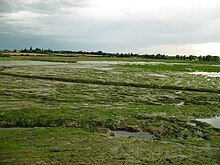
Managed retreat involves the purposeful, coordinated movement of people and buildings away from risks. This may involve the movement of a person, infrastructure (e.g., building or road), or community. It can occur in response to a variety of hazards such as flood, wildfire, or drought. Politicians, insurers, and residents are increasingly paying attention to managed retreat from low-lying coastal areas because of the threat of sea level rise due to climate change.[1] Trends in climate change predict substantial sea level rises worldwide, causing damage to human infrastructure through coastal erosion[2] and putting communities at risk of severe coastal flooding.[3]

The type of managed retreat proposed depends on the location and type of natural hazard,[4][5][6] and on local policies and practices for managed retreat. In the United Kingdom, managed realignment through removal of flood defences is often a response to sea-level rise exacerbated by local subsidence. In the United States, managed retreat often occurs through voluntary acquisition and demolition or relocation of at-risk properties by government.[7][8] In the Global South, relocation may occur through government programs.[9] Some low-lying countries, facing inundation due to sea-level rise, are planning for the relocation of their populations, such as Kiribati planning for "Migration with Dignity".[10]
- ^ Kool, Rick; Lawrence, Judy; Drews, Martin; Bell, Robert (2020-11-01). "Preparing for Sea-Level Rise through Adaptive Managed Retreat of a New Zealand Stormwater and Wastewater Network". Infrastructures. 5 (11): 92. doi:10.3390/infrastructures5110092. ISSN 2412-3811.
- ^ Leatherman, S. P., Zhang, K., & Douglas, B. C. (2000). Sea level rise shown to drive coastal erosion. Eos, Transactions American Geophysical Union, 81(6), 55-57.
- ^ Vitousek, S., Barnard, P. L., Fletcher, C. H., Frazer, N., Erikson, L., & Storlazzi, C. D. (2017). Doubling of coastal flooding frequency within decades due to sea-level rise. Scientific reports, 7(1), 1-9.
- ^ Greiving, Stefan; Du, Juan; Puntub, Wiriya (7 November 2018). "Managed Retreat — A Strategy for the Mitigation of Disaster Risks with International and Comparative Perspectives". Journal of Extreme Events. 05 (2n03): 1850011. doi:10.1142/S2345737618500112. S2CID 169804224.
- ^ Siders, A.R.; Hino, Miyuki; Mach, Katharine J. (23 August 2019). "The case for strategic and managed climate retreat". Science. 365 (6455): 761–763. Bibcode:2019Sci...365..761S. doi:10.1126/science.aax8346. PMID 31439787.
- ^ Hino, Miyuki; Field, Christopher B.; Mach, Katharine J. (May 2017). "Managed retreat as a response to natural hazard risk". Nature Climate Change. 7 (5): 364–370. Bibcode:2017NatCC...7..364H. doi:10.1038/nclimate3252.
- ^ Cite error: The named reference
Mach et al 2019was invoked but never defined (see the help page). - ^ Siders, A.R. (October 2019). "Managed Retreat in the United States". One Earth. 1 (2): 216–225. Bibcode:2019OEart...1..216S. doi:10.1016/j.oneear.2019.09.008.
- ^ Ajibade, Idowu (2 September 2019). "Planned retreat in Global South megacities: disentangling policy, practice, and environmental justice". Climatic Change. 157 (2): 299–317. Bibcode:2019ClCh..157..299A. doi:10.1007/s10584-019-02535-1. S2CID 201716223.
- ^
McNamara, Karen E (May 2015). "Cross-border migration with dignity in Kiribati". Forced Migration Review.
The 'migration with dignity' policy is part of Kiribati's long-term nation-wide relocation strategy.
© MMXXIII Rich X Search. We shall prevail. All rights reserved. Rich X Search
